Ant Plants (Myrmecophytes)
Asia-Pacific
04/02/22
What would it feel like to live inside a plant?
Climate control, constant space expansion, and even free food is up for offer with this group of unique tropical myrmecophytes.
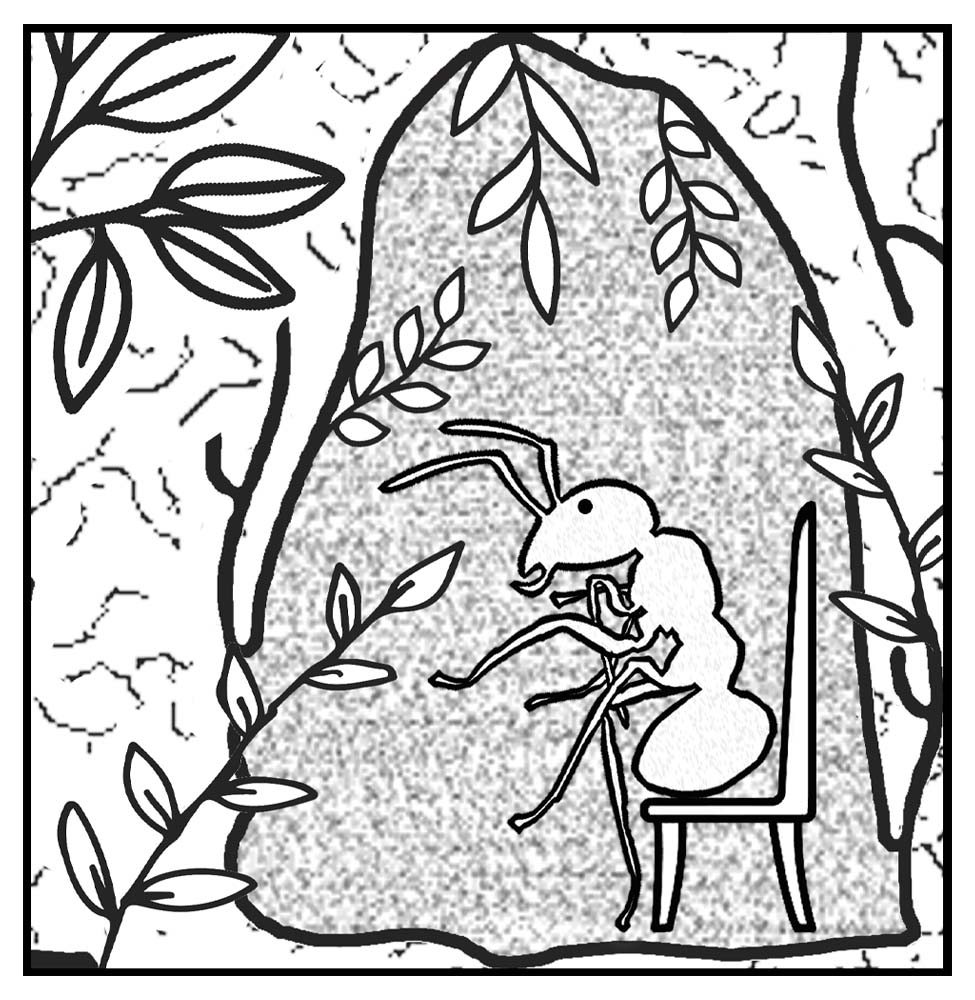
A myrmecophyte (literally translating to 'ant plant') is any plant that has evolved to live in a mutualistic relationship with ants. This highly beneficial relationship has proved so valuable that these adaptations have evolved many times in more than 100 different genera of plants.
There are several specific types of these relationships, including myrmecophily (using ants for pollination), myrmecochory (relying on ants for the dispersal of seeds), and myrmecotrophy (where ants feed the plants, providing them with nutrients). These services are traded for a place to shelter and nest, a source of food, or sometimes even both. The kind of interaction changes depending on the species and how/where the plants grow.
Epiphytes are plants that grow on other plants, with many living their whole lives in the canopy and never touching the soil. So where do they get their nutrients from? For the numerous species of epiphytic myrmecophytes, their problems are solved by their own food home delivery service: the ants.
This is one of the classic ant-plants, Hydnophytum formicarum, with a large tuberous caudex and attachment roots to cling to their host trees. They are native to South East Asia and grow in humid, hot areas often in full sun. This large caudex is hollow and spongy, containing many interconnected chambers for ant colonies to inhabit. To attract the ants and get them to stay, this species produces nectar as a food source for its inhabit'ants'.
Now you might think, wait a second... If the ants are feeding the plants and the plants are feeding the ants, what's the point even? Well it all comes down to the chemistry of the food!
These plants are in desperate need of macronutrients like nitrogen and phosphorus, and micronutrients like calcium. These nutrients are normally obtained from the soil, but these plants are restricted to life in the trees. Luckily the ants, which eat a variety of foods including other animals, gather all of these nutrients in their daily activities. They forage over a large area scavenging and hunting, then come back to rest at home (inside the plant) where they defecate in certain chambers. This seemingly 'waste' product is the most important source of these scarce nutrients for the plants. And it's deposited right inside of them!
As a reward for the ants, the plants generate sugars out of extrafloral nectaries - glands on the leaves and stems. Sugar is something plants have no problems creating, with no compound in its chemistry in short demand. In fact, all of the elements that make up sugar (carbon, hydrogen and oxygen) are able to be drawn out of the air and synthesised into a molecule with just a little bit of photosynthetic energy. And so the plants are reciprocating something they can create without shortage, in return for a scarce commodity.

Hydnophytum formicarum
Ant plant
The swollen caudex starts swelling and perforating at a young age, even without the presence of ants. The entry holes of this species of ant-plant are quite large, indicating that it can host larger species of ants. There are multiple entries and exits for every home.
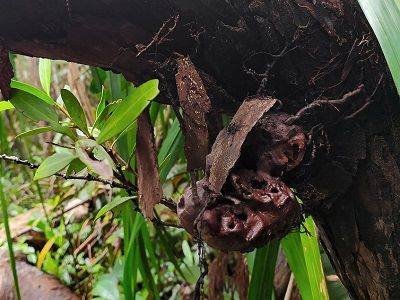
Hydnophytum formicarum
Ant plant
The plant uses its roots to attach strongly to its host tree. It is not a parasite however, and does not draw any nutrients from the tree - with the roots only functioning as an anchoring structure. Their leaves grow from numerous stems, usually branching from a central point.
The intricacy of this relationship becomes even more apparent when you take a look inside the plant. The swollen hypocotyl contains two types of chamber - smooth walled and rough walled. No nutrient absorption takes place in the smooth chambers, but the rough chambers are lined with an internal modified root matrix. Ants, being very organised and systematic, use the smooth chambers for nurseries and resting, and use only separate rough chambers for excrement, prey remains and food scraps, and the bodies of dead ants. The plant is then able to absorb this gifted resource as fertiliser.
Some of the cavities also act as a water storage mechanism, collecting small reservoirs when it rains. These can then be used by both the plant and the ants during dry periods, while also creating a microclimate by increasing humidity inside the plant.

Another service the ants provide is protection. Many species are intensely defensive of their plant-homes, attacking and devouring anything that lands on or disturbs the plant. This protection may even go too far, as these plants can no longer be well pollinated - with any bee or pollinating insect also getting eaten. Almost all epiphytic ant-plants are therefore self pollinating, with the ant providing the disturbance to move pollen within the flower.
Australia has three genera of epiphytic ant-plants, which comprise of the following species:
Myrmecodia
Hydnophytum
Dischidia
They are all restricted to the hot tropical environments of Queensland's far north, where they can stay moist in the humid air. Outside of Australia, their ranges also expand across much of South East Asia

The seeds of Dischidia species are wind dispersed with a fluffy parachute, however ants have been observed to seize these tiny seeds from where they fall and bring them into trees and places where they can germinate. The ants sometimes even take them directly from the seed pods before they have a chance to drift away. Myrmecodia and Hydnophytum species have a different kind of fruit, with seeds enclosed in a small bright orange or red berry. The ants act in much the same way with these plants however, opening the berry up and pulling out the seeds. They then carry these away from the plant, over and away from any potential predators, to a spot close by on the tree where it will safely germinate and expand the space for their colony. In this way, the ants are effectively gardening their own housing! Sometimes, a bird will manage to eat a few berries (a risky endeavour given all the aggressive ants), in which case the seeds behave exactly like a mistletoe would, passing though the bird and growing once deposited on a far away branch.

Myrmecodia tuberosa
Ant-house plant
This plant can be found across South East Asia to the northern tip of Cape York Peninsula in Australia. It is the spiniest of three Myrmecodia species found in Australia.

Myrmecodia tuberosa
Ant-house plant
This is a plant serious about protection. The base of the leaf petioles form an impenetrable shield of overlapping spiny plates
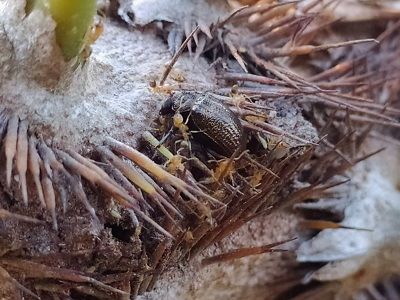
Myrmecodia tuberosa
Ant-house plant
Underneath these plates are hundreds of openings which allow ants to swarm across the entire plant in response to the slightest disturbance... This beetle never stood a chance

Myrmecodia tuberosa
Ant-house plant
Even the tiniest plants try to make the most of their relationship with the ants. This species tends to have smaller openings that cater to smaller ant species, particularly Philidris cordata.
While these ball-shaped plants manage to offset a good portion of their weight by being mostly hollow space, many fall off when they become too heavy. This is actually their greatest weakness, with most ant-plants often prematurely ending up on the forest floor to rot.
Many species of the Dischidia genus have avoided this fate, by instead growing extensive chains of 'small houses', rather than one large 'apartment complex'. Species such as the epiphytic Malaysian urn vine (Dischidia major), mostly grow small button-shaped leaves but can also produce a different type of leaf! This second leaf grows to form a hollow pitcher, up to the size of a thumb.
These are very interesting leaves, that act as the plant's own pot. As the leaf grows, a single root from a node enters the small opening at the base. This rapidly divides until it covers most of the internal surface. Most of the leaf's stomata (pores through which transpiration occurs) are also concentrated across the inner surfaces. This creates a moist environment, and as the ants continually deposit more materials into the pitchers, a kind of moist soil is created. The plant then carries its own soil, inside these leaves!
They grow by twining around trunks and branches, having a preferences for older and decaying trees. The small, round leaves are produced on elongated, fast growing stems, while the pitchers are grown in dense, tight clusters - allowing the ants easy access between 'buildings'.
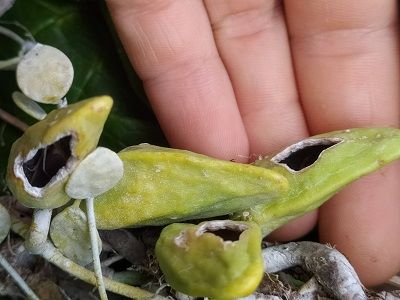
Dischidia major
Malayan urn vine
It is not uncommon to find these plants with wide holes chewed out of the leaves, and large ants sitting inside. They cannot get through the small natural opening, but force their way in to get access.

Dischidia major
Malayan urn vine
Immature pitcher-leaves, showing how the leaves grow by slowly puffing out from the center.
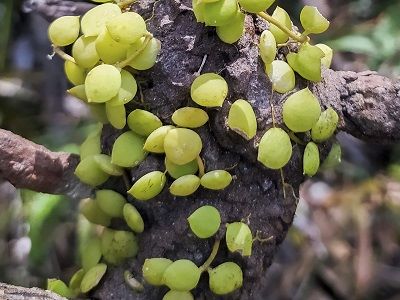
Dischidia nummularia
String of nickels
This species looks very similar to the non-myrmecophytic leaves of Malayan urn vine. While in the same genus, it is not considered an ant plant.
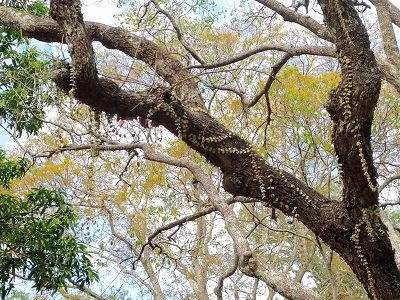
Dischidia nummularia
String of nickels
Almost reminiscent of Christmas lights, these succulent vines have no problems decorating the trees they call home.
Even ferns take advantage of the mutualistic relationship with ants. Lecanopteris sinuosa, a hardy rainforest epiphyte, grows a thick, hollow rhizome to shelter ants. The rhizome continuously grows as the fern climbs up and around the tree, constantly expanding the habitat for the ants. It has been observed that the ants feed from the fern at night, eating the spores out of the sori, which are a rich source of protein and fat. Some spores however attach themselves to the ants - likely aiding in their dispersal.